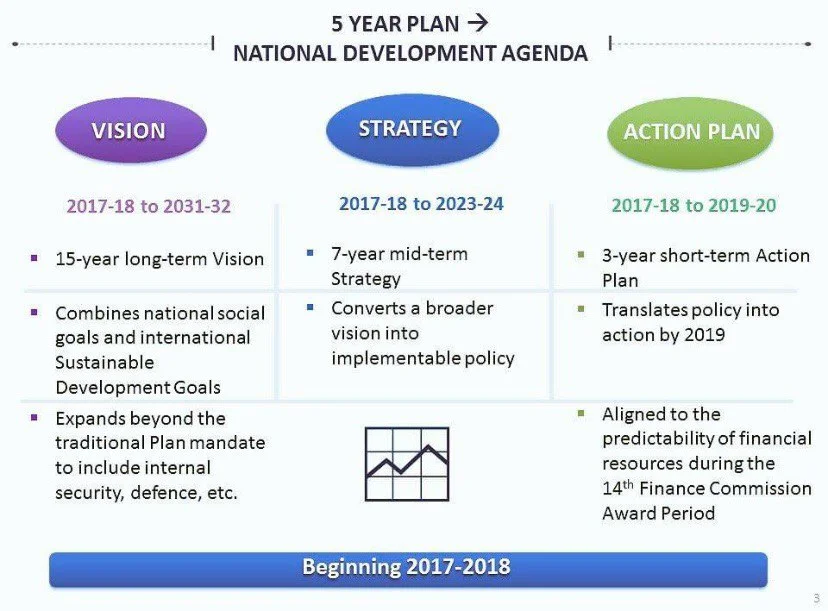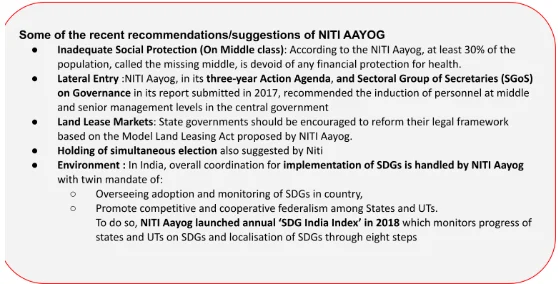The NITI Aayog, established to replace the Planning Commission, has set a new course for India’s development through its National Development Agenda. Focused on innovation, cooperative federalism, and sustainable growth, the NITI Aayog has driven significant advancements in various sectors, from entrepreneurship to agricultural development. Despite its achievements, the organization faces several challenges that must be addressed to fully realize its potential as a catalyst for India’s transformation.
Enroll now for UPSC Online Course
NITI Aayog: Navigating Achievements and Overcoming Challenges in India’s Development
NATIONAL DEVELOPMENT AGENDA OF NITI AAYOG
- The five-year plan strategy of the erstwhile Planning Commission has been replaced by the National Development Agenda of the NITI Aayog.

Achievement Of NITI Aayog
Compared to the Planning Commission , when it was replaced by NITI Aayog,in short span it has made many achievements:
- Innovation and Entrepreneurship: NITI Aayog gives more of its focus on innovation; they give more of their support to entrepreneurial services by collaborating with national and international experts.
- Example: Atal Innovation Mission and Atal Tinkering Labs.
- Cooperative Federalism: It collaborates with the state as teamwork to work towards the national development agenda.
- Example: it hosted three sub-groups of chief ministers on revamping schemes like Skill Development, Namami Gange programme and Swachh Bharat Mission.
- Agricultural Development: The first decision taken in the first meeting of the governing council of NITI Aayog held on 8 February 2015 was a task force on agricultural development.
- Food is the very first necessity of every person.
- So, the primary focus of NITI Aayog was on agricultural development.
- Increase in FDI: The creation of jobs and an increase in productive capacity, which can be directly measured in aggregate supply, is called an increase in FDI.
- NITI Aayog is also investing in foreign goods to increase its share in foreign currency, which increases the liquid capacity of the Indian currency.
- Suggestions by NITI Aayog:

Major Initiatives Taken

Challenges Faced by NITI Aayog
The NITI Aayog, the premier think tank of the Government of India, faces several challenges in fulfilling its mandate of steering India’s transformation. These challenges can be broadly categorized into structural, institutional, and functional issues.
- Structural challenges:
-
- Fragmented Governance: India’s federal structure, with power divided between the central and state governments, can lead to coordination issues and impede the implementation of NITI Aayog’s recommendations.
- Limited Data Availability and Quality: The lack of reliable and timely data at the national, state, and district levels hinders effective policymaking and evaluation of NITI Aayog’s initiatives.
- Inadequate Capacity at State and Local Levels: The capacity of state and local governments to implement NITI Aayog’s plans and programs varies significantly, leading to uneven development across the country.
- Institutional challenges:
- Perceived Lack of Autonomy: NITI Aayog’s position within the government structure can raise concerns about its independence and ability to provide unbiased advice.
- Coordination with Ministries: NITI Aayog needs to effectively coordinate with various ministries to ensure that its recommendations are aligned with sectoral policies and programs.
- Engagement with Stakeholders: NITI Aayog needs to actively engage with a wide range of stakeholders, including state governments, industry, academia, and civil society, to build consensus and support for its initiatives.
- Functional challenges:
-
- Prioritization and Resource Allocation: NITI Aayog faces the challenge of prioritizing among competing policy areas and allocating scarce resources effectively to maximize impact. Unlike the Planning Commission, it has no financial role.
- Example: no say in GST slabs’ revision
- Monitoring and Evaluation: NITI Aayog needs to strengthen its monitoring and evaluation mechanisms to track the progress of its initiatives and assess their impact on development outcomes.
- Communicating Impact: NITI Aayog needs to communicate its work and impact to the public effectively to build trust and support for its initiatives.
- Prioritization and Resource Allocation: NITI Aayog faces the challenge of prioritizing among competing policy areas and allocating scarce resources effectively to maximize impact. Unlike the Planning Commission, it has no financial role.
Enroll now for UPSC Online Course
| Must Read | |
| Current Affairs | Editorial Analysis |
| Upsc Notes | Upsc Blogs |
| NCERT Notes | Free Main Answer Writing |
Conclusion
NITI Aayog has made notable strides in driving India’s progress, particularly in fostering innovation and cooperative federalism.
- However, it must overcome structural, institutional, and functional challenges to continue its mission effectively.
- By addressing issues such as fragmented governance, data limitations, and the need for stronger stakeholder engagement, NITI Aayog can further enhance its role in shaping a prosperous and inclusive future for India.
Sign up for the PWOnlyIAS Online Course by Physics Wallah and start your journey to IAS success today!
| Related Articles | |
| NITI Aayog | Planning Commission and India’s Five-Year Plans |
| Cooperative Federalism in India: Significance, Background & Importance | Development of Agriculture in India |

 GS Foundation
GS Foundation Optional Course
Optional Course Combo Courses
Combo Courses Degree Program
Degree Program












